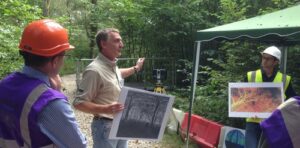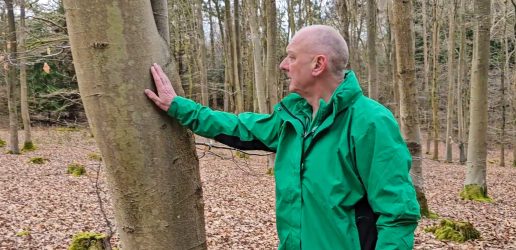In May, a major new campaign called Action Oak was launched at the Chelsea Flower Show. The campaign aims to build support for activities to protect the UK’s 121 million oak trees in UK woodlands.
Made up of charities, environmental organisations and landowners, including Forest Research, the Action Oak Partnership was formed in response to an increasing number of threats to the health of oak trees. These include pests and diseases such as the Oak Processionary Moth and Acute Oak Decline (mainly affecting southern regions of the UK), as well as a root-attacking species of honey fungus and powdery mildews (which are more widespread). Our changing climate creates further challenges.
The activities of the Partnership include:

Scientists from Forest Research have contributed to a baseline review of knowledge and hope to be involved, along with others, in future oak tree research. At a recent visit of the Action Oak steering group to the Birmingham Institute Of Forest Research (BIFOR) study site, Forest Research’s Eric Casella demonstrated his use of ground-based LiDAR to profile changes in biomass and canopy structure in an oak woodland subject to the enhanced levels of carbon dioxide likely to be experienced in future.
The initiative is supported by the Scottish, Welsh and Northern Ireland governments and by Defra. The partners include the Woodland Trust, Woodland Heritage, National Trust, The Duchy of Cornwall, Royal Botanic Gardens, the Forestry Commission and the Northern Ireland Forest Service.
For further information on Forest Research’s involvement please contact Chris Quine.

Forest Research, in partnership with Edinburgh Napier University, have taken a first step in systematically assessing the timber potential of underutilised species in the UK.
Tree professionals working in arboriculture are being asked to take part in a new tree health survey as part of a DEFRA-funded project looking at pathways and practices concerning the tree disease, canker stain of plane.

Nature, the world’s leading multidisciplinary science journal, has published findings from a new global study investigating which tree species fix the most carbon.

Forest Research, in partnership with Edinburgh Napier University, have taken a first step in systematically assessing the timber potential of underutilised species in the UK.
Tree professionals working in arboriculture are being asked to take part in a new tree health survey as part of a DEFRA-funded project looking at pathways and practices concerning the tree disease, canker stain of plane.

Nature, the world’s leading multidisciplinary science journal, has published findings from a new global study investigating which tree species fix the most carbon.